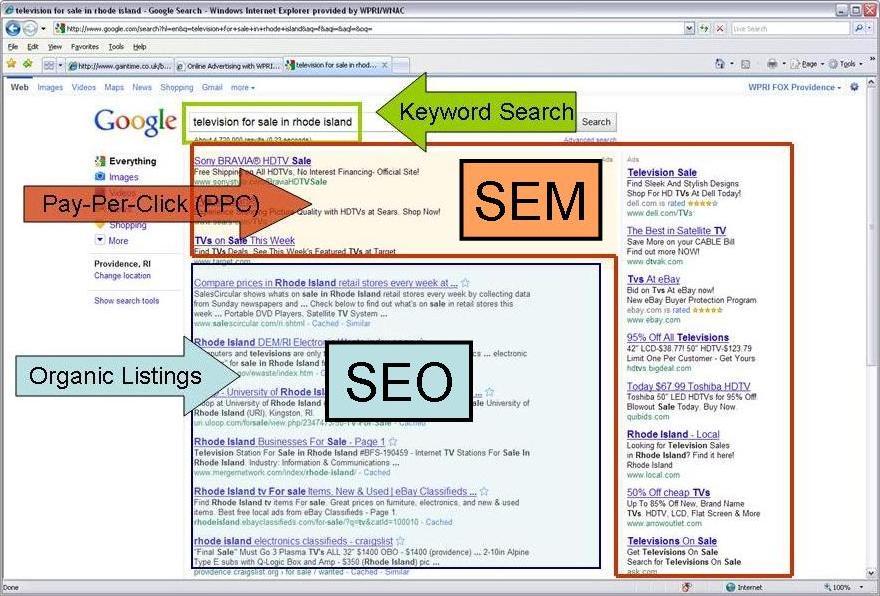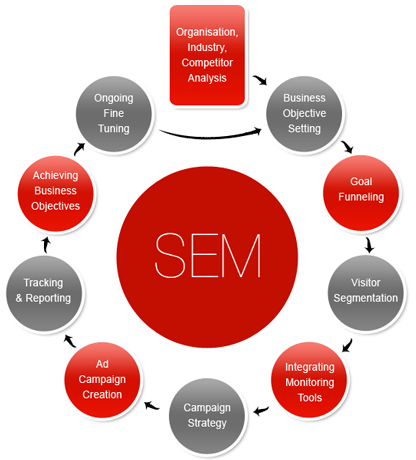What is Search Engine Marketing?
by Spencer Wade
Search Engine Marketing (SEM) is a blanket term used to describe all forms of internet marketing. SEM concerns the promotion of websites by increasing their visibility in search engine results pages through optimization (on-page and off-page), and through paid placement, contextual advertising, paid inclusions, and other advertising avenues. SEM can be a broad term for a plethora of website marketing techniques. These include everything from search engine optimization where a higher search result is gained through adjustment or rewriting of content to pay-per-click marketing where the focus is solely on the individual paid components of the marketing strategy.
What is the Market for SEM?
The market for SEM is growing at an exponential rate. In the US alone in 2008, advertisers spent $13.5 billion on search engine marketing. The fact that the technology involved is so complex means that a secondary SEM agency market has evolved to handle the workload. Many marketers find the complexities of search engine marketing difficult to understand, so they rely solely on third party agencies to manage their endeavors in the field. Google Adwords, Microsoft AdCenter, and Yahoo! Search Marketing are the largest vendors of SEM service. They expect SEM to grow much faster than traditional advertising, and even outpace other channels of online marketing.
SEM History
In the late 1990s, the number of Internet sites dramatically increased. Search engines were developed to help users find specific information quickly. The firms developing search engine technology developed business models to finance their services, and the field of SEM began to grow at a dramatic pace. As of 2007, pay-per-click programs proved to be the primary revenue streams for these firms. Google has grown to dominate this market through their Adwords service, so Microsoft and Yahoo announced, in 2009, their intention to join forces. This alliance was approved by regulators in 2010, but Google has yet to be replaced as the preeminent service in SEM.
Search engine optimization professionals have offered new services year by year. Many of these services are geared toward helping clients understand and use the advertising avenues open to them through search engines, and new agencies have formed through the mergers of many marketing and advertising firms to better serve their clients in these areas. SEM, coined by Danny Sullivan in 2001, covers the spectrum of activities involved in SEO, submitting sites to directories, managing paid listings, and developing online marketing strategies for organizations, individuals, and businesses.
Metrics and Methods
There are many metrics and methods used to optimize websites through Search Engine Marketing. The following list includes many of these, and a brief description of each:
- Keyword Research and Analysis: There are three steps involved in this process of keyword research and analysis. These are (1) ensuring the site can be indexed in search engines, (2) finding the most relevant and popular keywords for the site and its products, (3) and using those keywords in a way that generates and converts traffic.
- Website Saturation and Popularity: The presence a website has on a given search engine can be analyzed through the number of pages indexed for the site, or saturation, and how many backlinks the site has which is known as its popularity. This requires keywords people are looking for being included in the content of the page, and these keywords ranking high enough in the search engines rankings. All search engines have some form of link popularity in their ranking algorithms. There are tools that measure various aspects of saturation and link popularity such as Link Popularity, Search Engine Saturation, Top 10 Google Analysis, and Marketeap’s Link Popularity.
- Back End Tools: The back end tools in SEM include Web Analytics and HTML validators that provide data on a site and its visitors, and allow for site success to be accurately measured. Log file tools, simple counters, and more sophisticated tools based on page tagging are all tools used on the back end to deliver coversion-related information. Validators monitor the invisible parts of websites to highlight potential problems and usability issues. This helps to ensure that a site meets W3C code standards.
- WhoIs Tools: These tools reveal the owners of various websites, and provide information relating to copyright and trademark issues.
Paid Inclusion
The need for search engine developers to turn a profit was the impetus behind the advent of what is known as paid inclusion. This is where a company is charged a fee by the search engine developer for the inclusion of their site in results pages. Paid inclusion products, also known as sponsored listings, are provided by search engine companies like Google, Microsoft, and Yahoo.
Structured as both a filter against superfluous submissions and a revenue generator, the fee covers an annual subscription for one webpage that will automatically be catalogued regularly. Some companies have turned to a non-subscription based pay structure where listings are displayed permanently. A pay-per-click fee may apply in these instances. Search engines are all different. One may only offer paid inclusion, though this has been proven to be less successful, while others offer a mix of per-page and per-click fees with web crawling. Google does not allow webmasters to pay for listings, and advertisements are shown separately and labeled as such. The rise of paid inclusion has its detractors as well. Many believe that it causes results to be returned based more on the economic standing of the website’s interests, and less on the relevancy of the site to end-users.
The line between pay-per-click advertising and paid inclusion is debatable. There has been a move by some to insist that paid listings be labeled as advertisements. This move has been counteracted by others stating that since webmasters do not control the content of the listing, its ranking, or whether it is shown to any users it cannot be identified as an advertisement. The debate is still raging among SEM professionals. Yet, paid inclusion has advantages that cannot be denied. It allows site owners to specify schedules for crawling pages. Usually one has no control over when their page will be crawled, or even added to a search engine index. Paid inclusion is particularly useful when pages are generated dynamically and modified frequently.
Search engine optimization, of which paid inclusion is a part, allows firms to test different approaches to improve ranking, and see results within a couple of days instead of weeks or months. The knowledge gained from this experimentation can be used to optimize other pages without paying the search engine company for those as well.
SEO Comparison
Search engine marketing is the broad term that includes search engine optimization. SEM includes both paid search and organic search results. SEM uses paid advertising through services like Adwords, pay-per-click, and article submissions to ensure SEO has been done. Analysis is performed on the keywords in both SEM and SEO, but not necessarily simultaneously. SEM and SEO must be monitored and updated frequently to reflect evolving best practices.
There are certain contexts under which SEM is used exclusively to mean pay-per-click advertising. This is particularly true in the commercial advertising and marketing communities. The wider search marketing community is engaged in other forms of SEM such as search engine optimization and search retargeting.
The field of SEM contains the rapidly growing environment of social media marketing (SMM). SMM exploits social media sites to convince consumers that one company’s products or services are valuable. The field of SMM has experienced a broad range of theoretical advancements in its short lifespan. This includes search engine marketing management (SEMM). This relates to activities including SEO, but focuses on return on investment (ROI) management instead of relevant traffic building. It also integrates organic SEO in an attempt to get top ranking in search engines without using paid services or pay-per-click SEO. This is the future of SEM in the social media dominated world we live in.
Conclusion
The broad spectrum of services and firms that offer SEM to their clients is growing every day. This is a direct reflection of the industry’s growth as a whole, and its importance to the marketing community in terms of dollars spent by clients. The next few years will see an explosion of new methods and technologies that will allow a company’s marketing dollars to go further, and give clients the means to achieve their marketing goals without relying on traditional marketing. The future is now in SEM, and the future looks bright indeed.




One Comment Add yours